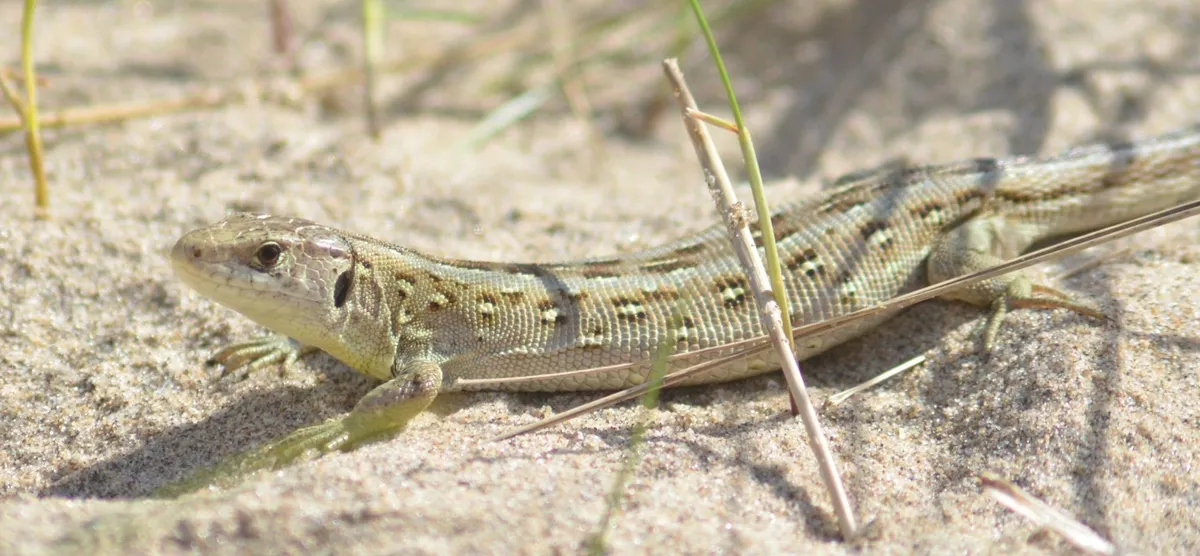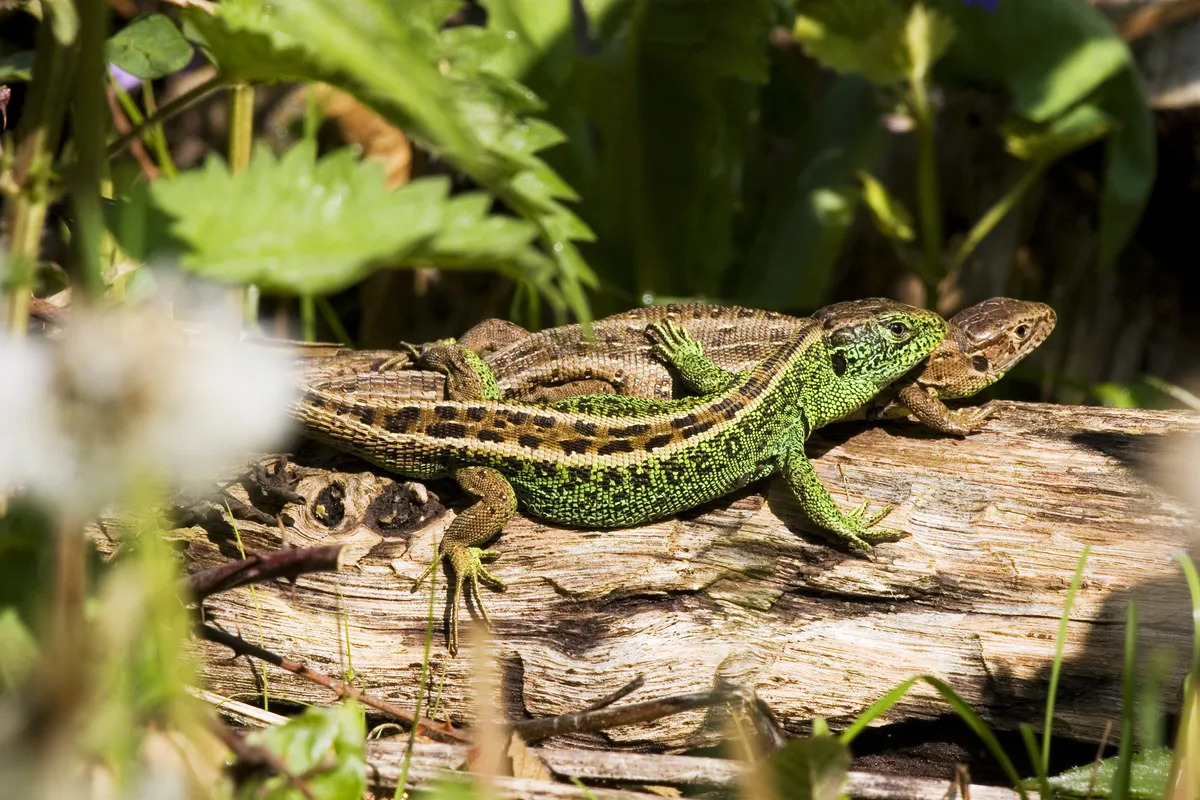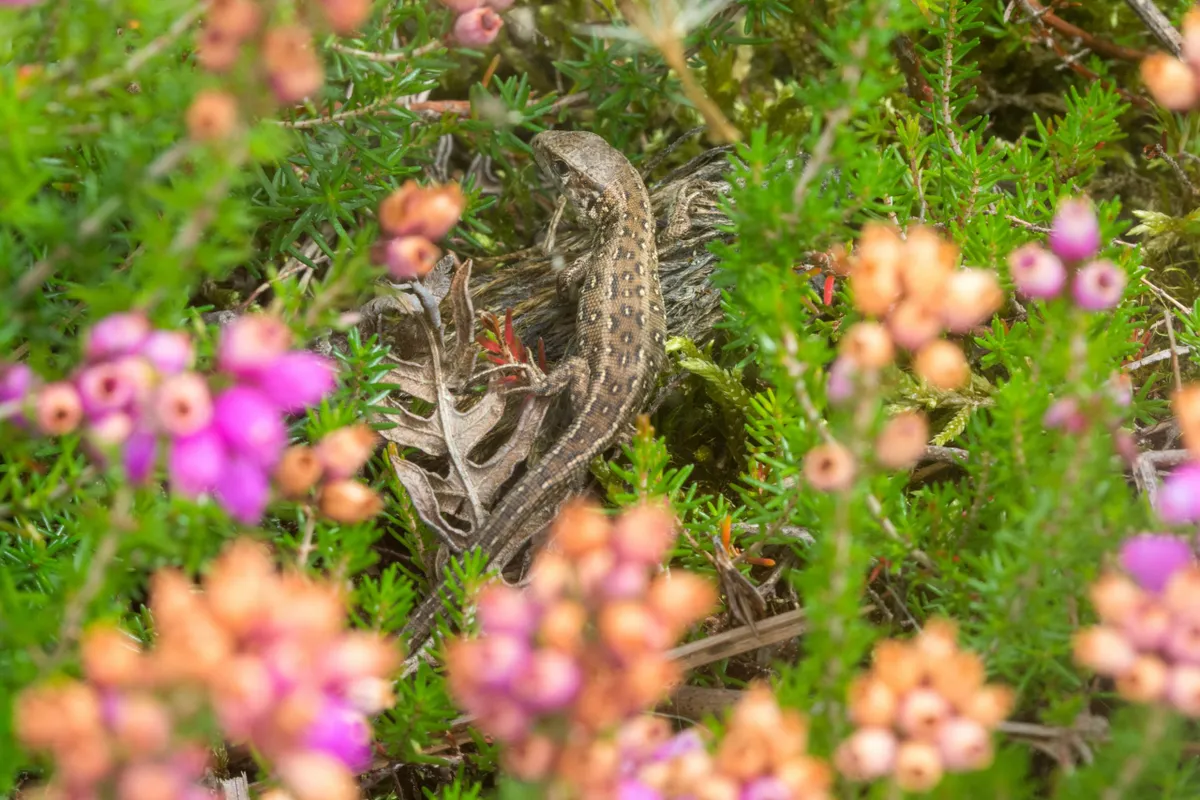Learn about sand lizards, including why they are rare in the UK, where they are found, and what's being done to help them, in our expert guide by the Amphibian and Reptile Conservation Trust (ARC).
Where are sand lizards found?
The sand lizard is the UK’s rarest lizard and is restricted to south and west England, and to a couple of sites in Wales. A small population can be found on the Isle of Coll in the Inner Hebrides in Scotland, as 39 individuals were released by scientists in the 1970s, to test whether they could survive so far north.
Outside of the UK, sand lizards can be found across much of Europe, although it has limited distribution in Scandinavia and the Iberian Peninsula. It is also found in the western areas of Russia, Mongolia and China.

In the UK, sand lizards are found on sand dunes and dry lowland heath. On heathland they prefer unshaded heather that is interspersed with open bare ground for egg-laying and they are found on predominantly south facing slopes. On dunes they prefer areas with mature marram grass. Such habitats provide them with warmth, cover from predators and suitable prey.
What is the scientific name of the sand lizard?
The scientific name of the sand lizard is Lacerta agilis, and it is the only native UK species in the Lacerta genus.
The common lizard, also known as the viviparous lizard, was formerly considered to be in the Lacerta genus, but is now in the Zootoca genus.
How to identify sand lizards
The sand lizard can be easily mistaken for the common lizard and non-native wall lizard. They are stocky, with brown varied patterns down the back, with two strong dorsal stripes. They can reach up to 20cm in length.
The male has green-yellow flanks, which are particularly bright during the breeding season in late April and May. Females typically have brown to grey background colour (for better camouflage).
Sand lizards have prominent “eye spot” markings (darker brown markings with white-cream centres).
In contrast, both the common and wall lizard are far more slender.
What do sand lizards eat?
Sand lizards eat a variety of spiders and insects. In general, reptiles are cold-blooded so very energy efficient so they do not need to eat very much.
What predators do sand lizards have?
Native species that sometimes eat sand lizards include kestrel, corvids (crow, magpie), badgers and, where they occur, the UK’s rarest snake, the smooth snake.
On heaths bordered by urban areas they are also preyed on by domestic cats.
Loss of vegetation cover, for example because of fire, can have a high impact on sand lizards by making them more vulnerable to predators.
Do sand lizards hibernate?
Sand lizards dig burrows in which to hibernate. Males can begin hibernation from late August-early September but females often start to hibernate about a month later, in September or early October.
Sand lizards emerge from hibernation in April and May.

Do sand lizards lay eggs?
Sand lizards dig an egg-burrow in open bare ground in June and lay a clutch of 6-12 eggs. These hatch after 2-3 months, usually in late August and early September.
Sand lizards are the only native UK lizard species to lay eggs, which is known as oviparity. Both common lizards and slow worms give birth to live young, known as viviparity.
Please note that external videos may contain ads:
A juvenile sand lizard hatching from its egg. © Paul Hudson/ARC
Please note that external videos may contain ads:
A juvenile sand lizard. © Jack Perks Photography
Are sand lizards endangered?
Sand lizards are listed as Least Concern on the IUCN Red List, but are relatively rare in the UK.
Historically, habitat loss and fragmentation of the two rare habitats where sand lizards are found (dune and heath) has been very severe. For example, in Dorset 85% of heathland has been lost since the 18th century and remaining heathland has been fragmented into more than 150 isolated sites.
The primary causes of habitat loss are urban development, or shading as scrub becomes dominant during vegetative succession. Around 85% of Wealden heaths (south of Waverley and into Hampshire) were known in the late 18th century were lost by the 1970s.
Afforestation on and near heathland sites, agricultural reclamation, military activity and mineral excavation have also contributed to the loss of sand lizards from sites where they once occurred. The remaining sites for sand lizards are mostly fragmented and isolated, putting these populations at risk from heath fire and dune erosion.
In Merseyside around 50% of dunes were lost and a further 12% were modified between 1801 and the1970s, while many of those that remain are fragmented.
This habitat loss has driven declines of the species. Since the 20th century populations in Dorset, Weald and Merseyside have declined by 90%, 95% and 97% respectively.
What is being done to protect sand lizards in the UK?
The sand lizard is a conservation priority in England and Wales. Conservation work focuses on maintaining remaining populations, re-establishing the species across its historical range through reintroduction, and restoringhabitats to link existing sites.
The species is strictly protected under British and European law which makes it an offence to kill, injure, capture or disturb them; damage or destroy their habitat; or to possess or trade in them.
Heathland restoration management benefits sand lizards and other reptiles including other rare species, such as the smooth snake. The removal of colonising trees such as birch and pine is crucial to maintaining open heath vegetation this species needs. Open sand patches are also created to provide areas for sand lizards to lay their eggs.
ARC manages nature reserves where sand lizards and other reptiles can thrive, and monitors the condition of the habitat and how sand lizard populations are faring.
Amphibian and Reptile Conservation (ARC) has, over many years, worked with partners to reintroduce the sand lizard to sites within its historic range. More than 10,000 animals have been released into the wild in dunes and heathlands in England and Wales.
Q&A with conservation scientist Rachel Gardner
Rachel Gardner is a PhD student at the University of Southampton, and has been releasing juvenile sand lizards into heathland near Farnborough in Hampshire.
How are sand lizards bred in captivity?
Small groups are kept in naturalistic outdoor vivaria replicating the dry heath and sand dune habitats that the species inhabits in the wild.
In spring, males emerge, sporting their vivid green breeding finery. After mating, females lay up to 18 eggs, which are carefully excavated and artificially incubated to maximise their changes of survival.
Juveniles hatch within six weeks and, again, are held in outdoor vivaria until release.
How and where are the hatchlings released?
Juveniles and sometimes sub-adult lizards (of unknown sex) are released across a site in cohorts of 80 per year over three consecutive years.
Release sites are within the species' known or presumed range, but with no individuals present and causes of loss addressed.
Releases normally take place in early autumn, giving the lizards time to locate suitable overwintering sites, such as the burrows of small mammals.
What are a sand lizard's habitat requirements?
Sand lizards need habitat with a varied vegetation structuve that offers areas for both basking and sheltering, as well as sandy soils for egg-laying.
Through my research for the University of Southampton and Marwell Wildlife (in partnership with the Amphibian and Reptile Conservation Trust and Natural England), which involves tracking individuals using radio tags, I hope to learn more about how this species uses microhabitats following reintroduction.

Amphibian and Reptile Conservation Trust (ARC) is a wildlife charity committed to conserving amphibians and reptiles, and saving the disappearing habitats on which they depend.
Main image: A male sand lizard. © Alfred Trunk/McPhoto/ullstein bild/Getty





